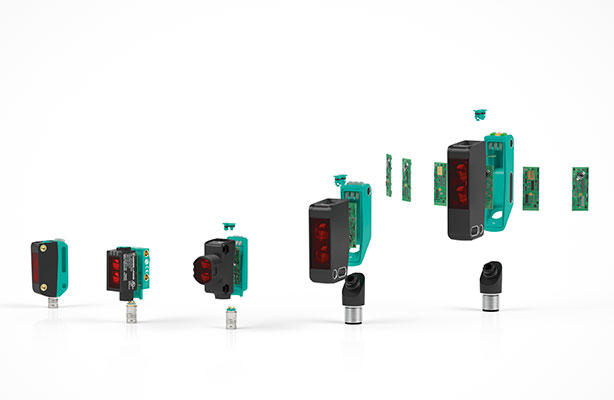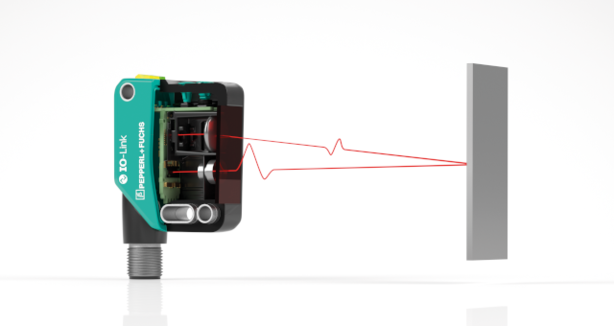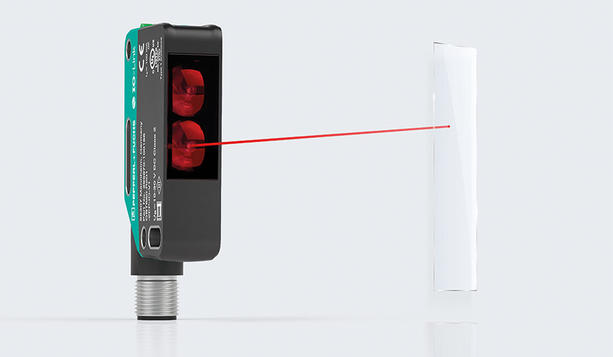
Redefining flexibility.
All functional principles in standard housings, high-performance sensor technologies and IO-Link in every model.
R10x and R20x Series Photoelectric Sensors
Innovative Technologies

Compact Housing Design
Intuitive User Interface
R10x and R20x Series for Maximum Performance
The compact R100, R101, and R103 series master short-range applications, while the medium-sized R200 and R201 series are perfect for longer-range sensing. This video shows you the specialties of both series as well as sample applications for the R20x series.
Flexibility Redefined—An All-Round Solution in Every Housing

The R10x and R20x series combine several photoelectric families of sensors with efficient technologies in one housing style. They differ only in mounting method and housing design. Once you determine how you would like to mount the sensor, you can select the required functions based on the task at hand. This all-round solution provides a unique flexibility and opens up a variety of possible applications.
360°– Discover R100, R101, R103, R200 and R201
The R100, R101, R103, R200 and R201 series are available with the following functionalities:

*available in R100 and R101
Pulse Ranging Technology—Precision Over Long Distances

Pulse Ranging Technology (PRT) is a method developed by Pepperl+Fuchs that allows even large distances to be measured with high precision.
This technology is based on short laser pulses emitted by a powerful light source. A light-sensitive receiver element in the sensor detects the light pulses reflected by the object. The distance to the object is calculated precisely by directly measuring the time of flight of the light. The high energy density of the laser pulses enables long ranges to be achieved and interference to be effectively suppressed.
PRT sensors therefore offer maximum precision in distance measurement—even in demanding environments.
The Distance Sensors in the R200 Series with PRT
With the R200 distance sensor, Pepperl+Fuchs is integrating Pulse Ranging Technology into the compact design of 15 x 41.7 x 50.6 mm for the first time. This enables high-precision distance measurements where space is limited.
When measuring white objects directly, the R200 with PRT offers a range of 10 m. In the variant with a reflector, distances up to 60 m can even be measured. Find out more about the new distance sensor in this video.
Multipixel Technology—Success is Measurable
Pepperl+Fuchs' Multipixel Technology (MPT) enables highly reliable and interference-free distance measurement for near-range applications. This technology combines the measuring functionality of conventional distance sensors with the proven triangulation principle.
With this geometric method, an emitter—LED or laser—emits a light beam to the object, which reflects it back. The reflected light beam is then recaptured by a light-sensitive receiver in the sensor, the multipixel array. Depending on the position of the light spot on the receiver, the distance of the object to the sensor is calculated by geometric triangulation. This is done using intelligent software algorithms.
This enables measuring and switching R10x and R20x sensors to precisely measure the position of an object and clearly distinguish it from the background.
DuraBeam—The Best of Both Worlds

Laser sensors are extremely precise, but they are less durable and have a lower temperature range than LED sensors. Pepperl+Fuchs uses the best of both worlds and combines the strengths of LED sensors and laser sensors with its efficient laser technology DuraBeam.
The R10x and R20x series laser sensors ensure an extended service life and provide the user with new possibilities—even at ambient temperatures up to 60° C.
DuraBeam also uses a special beam profile, which reflects a sharply contoured, circular light spot on an object at any time. Sensors equipped with eye-safe DuraBeam laser technology are ideally suited for highly accurate detection and distance measurement of small objects.
Smart Sensor Profile: Pioneering the Standardization of IO-Link
Smart Sensor Profile is a standard that aims to ensure the same basic functionalities across all IO-Link sensor manufacturers. This includes access to settings, parameters, process data, and diagnostics.
All sensors that follow a specific Smart Sensor Profile display and evaluate process data the same way. This enables the use of function blocks for simple control integration. Existing user programs can be reused, which simplifies programming.
Pepperl+Fuchs is among the first manufacturers to implement version 1.1.3 of Smart Sensor Profile, the latest version published by the IO-Link consortium. This standard will also be implemented in future Pepperl+Fuchs products. Quickly and easily control automation processes in your plant!
Contact Us
What are the advantages the R10x and R20x photoelectric sensors offer for my plant? What are the right sensor variants for my specific requirements? We are happy to answer these and other questions. Simply arrange an appointment!
 Downloads
Downloads
- Brochure: R10x and R20x Series (PDF; 2 MB)







 More Information
More Information

 +358 20 7861 290
+358 20 7861 290